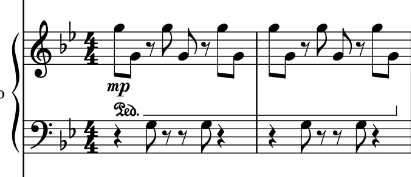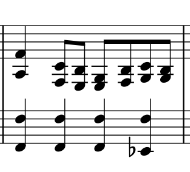All Activity
- Past hour
-
Henry Ng Tsz Kiu started following Tristesse
- Yesterday
-
PeterthePapercomPoser started following Tristesse
-
Hello I haven't uploaded anything here for some time. Too busy in what is actually my job.... But I have been studying (and continue...) the harmonic, and compositional world in general, of Romanticism. Which is fascinating. I really encourage anyone interested in composition to seriously study the resources of each period. We can always, always improve. So I am uploading this piece, after reviewing some Romantic works with that title.... I hope you like it. By the way, although I have hundreds of "works" written, I am discarding, reclassifying and renumbering from Op. 1, not caring if it is something written now or years ago, as long as it has some value to me.
-
Hello I liked it. It's a piece with uncomplicated and straightforward harmonies, with a defined melody that engages. What you are asking are different questions. I do not think it is a piece for children to learn to play (although it will depend on the level, of course). It seems easy apparently, but, although it is a software interpretation, it is full of dynamics and, for my taste, of an excess of octave lines.
-
A very random Quartet: Piano, Cello, Double bass and Drums
MJFOBOE replied to piajo's topic in Chamber Music
This work has the potential for further development. You do have a very interesting voice here. I love the effect of the lower strings creating an interesting floor for the piano and percussion. I think a bit more variation in the piano part would enhance the work. Keep at it! Mark -
Score please ...
-
Henry Ng Tsz Kiu started following Le Mariage Rouge
-
Thanks for sharing! Like @Nicholas Schuman, I listened a few times to it as it is so pleasant and engaging. Would be nice if you would pair it with a quick lively movement if you ever feel like it.
-
PeterthePapercomPoser started following Recit: Ich dich ehren , Le Mariage Rouge and Ricercata a 6
- Last week
-

A very random Quartet: Piano, Cello, Double bass and Drums
piajo replied to piajo's topic in Chamber Music
Oh wow, thank you so much for this amazing feedback! I appreciate it very much that you took the time to listen and write something so helpful! Ahh I can't tell if you're being nice or genuinely think that, but thank you very much! You are right, I just started trying to write music in scores, and I couldn't do it for a while because of my studies. This piece is something I started writing a while back, and I liked the initial piano melody, so I wanted to put this up in the forum. I resumed it recently and finished it in a rush because I was getting impatient, which is why the strings are so underdeveloped and why this is so short. Someone else here suggested developing the other instruments too on another piece I put up here, so I should definitely try that! It's also easier for me to write sensibly when I have my piano (I don't have access to a piano right now) with me so that I can actually play it and see the placement because I'm not good with sight reading and I've only just started writing, so this is great advice to develop my writing! It only occurred to me today that I should've given some of the bass's parts to the cello when I saw someone play the bass today - I should watch live performances and study these other instruments too when writing for them. Thank you very much, this is highly encouraging! -
kaiserkulp started following Le Mariage Rouge
-
I'm pretty new to all of this, mostly having fun with composition while I apply to medical school. This is the first big piece I tried to write, some errors here and there with some questionable passages, but I'm overall happy with it. Very open to criticism as I hope to improve this piece and others I hope to write as a way to ward off application anxiety. Main idea of the piece: it's about the death of Henry II of France at his daughter's wedding. The beginning is meant to be a little chaotic but joyous because it represents the many people of France, both of high and low standings, gathering for this momentous occasion (imagine flying over the castle and seeing the many people walking around, preparing things). The softer part afterward is meant to represent the princess as she readies herself for the festivities, including the jousting. Bell tolls signify the beginning of the joust, with everyone being summoned to watch the event. Once things become faster, imagine the knights galloping at each other, lances ready to unsaddle their opponent. The King is one of these knights, excited to take part in a sport he loves. The tension builds as the joust becomes quite dangerous, until the unthinkable happens and the King is launched off his horse, a part of his lance protruding from his visor. The uneasiness and sadness that follows portrays the people as they become worried about not only the King's health (as he will soon perish), but also the fate of France as the King's young son will claim the throne without any experience and proper guidance.
-
kaiserkulp joined the community
-
Electronic music with horn sections is where it's at. What a banger 😄 It does kind of linger though, what about a contrasting section on a few different chords? The cut out at about 2 min. was a nice change, but still the same harmony, right? The part at 2:45 to the end felt unfinished and unnecessary to me. Maybe just adding a bit of contrast with the chords would be good enough. If you like that end section, maybe just cut it shorter? I know you said this was done, so this would be for future compositions. Plus it's just my opinion haha. Awesome track! You seem to have a flair for sax writing, do you play? Thanks for sharing 👍
-

A very random Quartet: Piano, Cello, Double bass and Drums
Thatguy v2.0 replied to piajo's topic in Chamber Music
I love hearing stuff like this. To me it's a diamond in the rough. I can tell you are a beginner/novice with compositional technique, but your writing and ideas are your own. That's the thing no one can teach, and you have such a cool unique voice that I'd be sad if you ever stopped writing. I wouldn't say this sounds "rushed", but I think I know what you mean. There are things you fleshed out and developed (like the melody in the piano and the drum rhythms), but other parts you haven't (overall harmony is on 2 or 3 chords, bass part is boring). But what are you going for? I've heard plenty of music with a static harmony on a few chords, but melody and everything else are developed. For instance, as jaunty and extravagant as your melody is, it kind of meanders to me. Wondering around and noodling are fine, but imo there wasn't a destination. Since your harmony is static, what if you tossed the melody around to other instruments? Or gradually kept the melody notes rising to explore more of it's register? Lots of ways to expand this, just depends on what YOU want to do. Another idea is to explore forms. Study up on simple ones like binary and tertiary forms. Search "simple forms for composition", I bet you in .3 seconds an overwhelming heap of information will come your way. What an exciting time for you to get to try your hand at all of this! Keep writing simple pieces, short ones, that you can complete relatively quickly. You'll learn a lot faster and inspiration of KNOWING you can write and complete a piece will keep you going when "the spirit" or whatever doesn't. Adhering to a form is an easy way to fix the "I don't know what to do next" problem. If I were you, I'd keep writing for piano, or another instrument that's polyphonic so you can keep practicing harmony. AND, your piano writing will get better too. For instance: One thing you could do is have the beam of the eighth notes cross to the bass clef to include the low G. That way the performer will instantly recognize your rhythm, and at least to me it would be easier to read. I wouldn't expect you to know that, and it's definitely NOT a mistake per se, but as you continue to study scores, you'll see all kinds of engraving that you may not have come across, and that's one way to get better. Your rhythm changes soon after, but it's readability is something you should always consider when notating. Also, if there are notes in the bass clef, I would put the pedal marking under those notes. Watch out for stuff like this. The right hand notes go lower than your higher F note in the left hand, so it might be awkward to play. I would have maybe given the more athletic sections to the cello over the bass, but other than a few things that are easily fixable with your continued growth, you have a lot to look forward to after writing this. I think the style and the cool harmonies with the piano over the block chords are unique and your own. I encourage you to continue to explore this forum as well as ask questions for anything. Thanks for sharing, and good luck with your future music! -
Nice! Are you planning to put it on YT? I have a new YT channel in the works, and was thinking of using my own music to provide compositional technique or examples for it. You get to promote your work more, show it on a deeper level for those that care, and avoid copyright issues. Seems like a win win win 😄
-
Revision of an old exercise of mine composed on a given subject while experimenting in counterpoint in more than four parts.
-
Thanks for the comments! That final cadence has a strong plagal flavour (my original version had a much more straightforward g min - D maj progression there), I'm personally unable to hear it as not giving satisfactory closure. Back at university my fugal training was based predominantly on the French system (see for example Gedalge's treatise) according to which episodes are considered as developmental parts unlike the Baroque practice where they're just transitional parts, hence my different approach. I understand your point, though, I'll try to keep an eye on this next time when making another fugue from scratch. Thanks!
-
piajo started following Favorite video game music tracks?
-
Braid has a pretty nice soundtrack! I suppose it's style is a little classical, but it sets a great mood. https://www.youtube.com/watch?v=7mVKJdgF19k&list=PLE09A650B6C70332A&index=5 Going in another direction, Life is Strange has a nice soundtrack too. You have Jonathan Morali's sweet guitar, and then there's Daughter writing heavy impact music for Before The Storm (song like, but not quite): https://www.youtube.com/watch?v=Td330GWYYFQ
-
Henry Ng Tsz Kiu started following Recit: Ich dich ehren and The Fall of Chronos
-
Hey everyone! Just finished composing a piece inspired by the Titanomachy saga called 'The Fall of Chronos'. It's an epic symphony featuring a women's choir. I hope you'll like it. What's your opinion?
-
This will be movement 4 of my cantata (WIP). Text taken from Prometheus. A sample English translation is: I honour thee, and why? Hast thou e'er lightened the sorrows Of the heavy laden? Hast thou e'er dried up the tears Of the anguish-stricken? Was I not fashioned to be a man By omnipotent Time, And by eternal Fate, Masters of me and thee?
-
Absolutely any advice is appreciated because I don't know what I did here. I definitely want to revise this because it sounds rushed and I think I can expand this and improve this, but how is this as a first draft? Also, to any drummers, do the rhythms make sense? I tried it out on the drums and it made sense to me, but I don't really play the drums so I don't know.
-
nippon276 joined the community
-
TLDR: wrote my first piece ever, looking for ways to improve it PDF + WAV Hi all, I recently finished a free composition course called Write Like Mozart which is essentially an introduction to classical composition for beginners like myself. At the end there's a final project which has the following requirements: In rounded binary form (A-A'-B'-A')—my A is mm. 1-7 and the B is at mm. 15-18 3/4, 4/4, or 6/8 time 20-30 bars Scored for piano and one of concert flute, C trumpet, oboe, or violin One deceptive cadence—I put this at m. 18 One half cadence—see mm. 6-7 One perfect authentic cadence—last measure At least two different texture types - homorhythmic homophony, melody and accompaniment, polyphony, or monophony—I'm perhaps still a bit unclear on the differences between some of these but I think at least there's a melody/accompaniment/polyphonic thing going on and homorhythmic homophony in mm. 14 and 25 One sequential progression—my B section is basically a circle of fifths progression One basic progression that has been elaborated with diatonic substitution, chromatic substitution, and/or secondary dominant/leading tone chords—In terms of diatonic substitution, in m. 12 I used ii instead of IV for the predominant and vii° instead of V for the dominant. For chromatic substitution, I had planned to use modal mixture by swapping out IV for iv in the second bar of the A section, but it just sounded a bit off so I relegated it to half a measure in m. 20. Overall, I think it sounds okay, but I'm not sure what I should focus on to make it sound good. Creating the flute's line was already kind of difficult for me, so when it came to the treble staff I mostly left them as simple repeated intervals; I would've made it more polyphonic, but I wasn't really sure where to go. It was kind of hard to strike that balance between variation and repetition. You may also notice I got some "inspiration" from Mozart's K. 545. Again, I think it's okay, not sure if I would say the way I applied it is amazing. Perhaps it's also obvious I couldn't decide on a rhythm for the bass line either. I think in addition to general feedback, I'm particularly curious in the transitions. For example, I'm not sure if having the first bar of A being almost exactly repeated three times sounds too basic (or disjunct with other parts). In terms of voice leading, I think I started out with okay part writing but I kinda didn't focus on the rules so much when I started creating the melodic lines, but do let me know if there are any egregious errors. Somewhat related, I couldn't decide on the ranges of the "alto"/"tenor" lines at some parts so occasionally they're an octave lower, like with mm. 4-5. I know I shouldn't expect myself to write something amazing on my first try, but I just want the rough edges rounded off a bit. Note: I'm already aware I shouldn't have vi in first inversion in the deceptive cadence.
-
Very dramatic piece with nice twists. Bar 43 and following could have been cliché, but worked out well. Just two comments: What @Luis Hernández said; I just think it because of a different reason: In a typical fugue, you have blocs with the soggetto and episodes in between, often a bit formulaic, but they provide on one hand relief after the rigorous entries of the soggetto, and on the other hand creates tension: When will the next entry arrive? Your episodes are rather eventful and densely packed. Sometimes, it is ok to take some predictable phrases and be a bit formulaic to provide contrast. And the final cadence is an interesting experiment, I just think for many listeners it wont sound like it really closes the piece. In bar 70, you start with a g minor chord over a tonic pedal (plus a resolution of a 4 to a 3), changing to a D Major chord (f# + a over the pedal), which will invariably sound like the dominant chord for g, especially as you use a g - f# - g, a typical cantizans. Briefly, something like a diminished c# chord emerges, but you could probably make it all clearer by using f instead of f# in measure 70, and just touch f# in the last bar.




.thumb.png.8b5b433a341551e913a34392660bc95b.png)